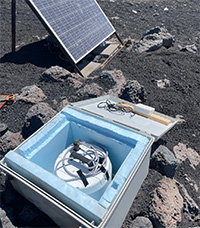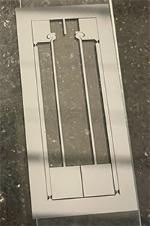From the JWNC to Mt Etna: A Pendulum Gravimeter is Taking Shape
Published: 22 October 2024
In 2015, more than 8% of the world’s population lived within 100 km of a significant volcanic eruption. How can we protect these vulnerable communities by accurately predicting when volcanoes will erupt?
In 2015, more than 8% of the world’s population lived within 100 km of a significant volcanic eruption. How can we protect these vulnerable communities by accurately predicting when volcanoes will erupt? The answer is gravimetry, which enables sub-surface changes in density to be measured. Gravity monitoring provides volcanologists with a method for assessing magma storage and dynamical changes to the conduit. However, current marketed gravimeters are prohibitively costly (>£250k) and heavy (>100kg) for use in harsh volcanic environments.
 Pendulums are the foundation upon which gravimetry was built, but technological boundaries in the 20th century limited their sensitivity and they were superseded by free-fall based systems. However, the innovation of MEMS (Microelectromechanical-systems) fabrication techniques is facilitating a renaissance in pendulum gravimetry. We develop these miniature silicon pendulums in the JWNC, using halo-etch patterns and deep reactive ion etching to construct highly sensitive measurement devices that push experimental limits.
Pendulums are the foundation upon which gravimetry was built, but technological boundaries in the 20th century limited their sensitivity and they were superseded by free-fall based systems. However, the innovation of MEMS (Microelectromechanical-systems) fabrication techniques is facilitating a renaissance in pendulum gravimetry. We develop these miniature silicon pendulums in the JWNC, using halo-etch patterns and deep reactive ion etching to construct highly sensitive measurement devices that push experimental limits.
 Unlike the current marketed gravimeters, MEMS devices are of sufficiently low cost to be deployed in bulk. Many of them can be placed on a volcano for a three-dimensional view of their magmatic plumbing systems. This project is associated with INGV who manage Mt Etna, a natural volcanic laboratory for device testing, and in future we aim to conduct fieldwork at Kīlauea volcano. These devices are also well-suited to water table monitoring and we are currently involved in water scarcity research alongside Queens’ University Belfast.
Unlike the current marketed gravimeters, MEMS devices are of sufficiently low cost to be deployed in bulk. Many of them can be placed on a volcano for a three-dimensional view of their magmatic plumbing systems. This project is associated with INGV who manage Mt Etna, a natural volcanic laboratory for device testing, and in future we aim to conduct fieldwork at Kīlauea volcano. These devices are also well-suited to water table monitoring and we are currently involved in water scarcity research alongside Queens’ University Belfast.
Phoebe Utting1,2, Kristian Anastasiou2, Karl Toland2, Abhinav Prasad2, Douglas Paul2, Giles Hammond2
1 James Watt School of Engineering, University of Glasgow
2 Institute for Gravitational Research, School of Physics and Astronomy, University of Glasgow
First published: 22 October 2024

